Final report for ONE17-308
Project Information
Small-scale vegetable farmers who are interested in organic production are continually seeking cost-effective and practical management practices that conserve soil, reduce labor, and increase the profitability and sustainability of their livelihood. Preliminary results of a demonstration trial at Rodale Institute in 2016 showed that using no-till low-input technology has the potential to conserve soil and sustain vegetable production.
Quiet Creek Farm owners John and Aimee Good grow organic produce for a 250-member CSA and are interested in cost effective management systems that reduce their dependence on frequent cultivations to conserve soil and ensure high yields. The Goods partnered with Rodale Institute and compared side-by-side the impacts of a reduced- tillage management system that included: a low-input technology (using 2-ft wide BCS roller crimper and hand planting) and high-input technology (using a10-ft wide roller crimper (RC) and no-till planter) with the grower's standard management system (multiple in-season cultivations and a water wheel for planting). They were interested in gaining knowledge and experience in using the reduced no-till equipment, and its feasibility and effectiveness on soil health and winter squash fruit nutrient quality upon prolonged storage. Similar treatments were compared with existing field trials at Rodale Institute. In the Rodale Institute trial, the low-input no-till system was compared to high-input no-till and plasticulture (standard farmers' practice) systems.
Our results showed that crop yield was lower in the reduced-tillage system (1/3 of the grower's standard system) due to low cover crop biomass [4,111 kg/ha (3,670 lb/acre)], well below the optimal threshold biomass of 8,000 kg/ha (7,000 lb/acre) when compared to the grower's standard system (multiple in-season cultivations). However, using a reduced-tillage management system enhanced nutrient concentrations of a-carotene, lutein, calcium, and phosphorus in winter squash when stored for 60 days. Total polyphenol concentrations increased by 1.75 times, 2 times, and 1.5 times in the BCS, RC, and the grower's standard treatments, respectively, as storage periods increased from 0 days to 30 and 60 days. Vegetable growers who have limited resources and capital may start by using the BCS, an affordable low-input technology, to roll-crimp the cover crop while producing high quality winter squash. In addition to enhanced nutrient levels of winter squash when using the high-input technology method, growers will observe reductions of 1/5 the time to roll-crimp the cover crop and 1/6 the time for transplanting seedlings as compared to those of the low-input technology system.
Results were shared with more than 22,000 people, including growers, researchers, educators and interested clientele through a variety of educational venues including the Rodale's Annual On-Farm Field Day, three tours, two articles in newsletters, a web article posted on Rodale's Institute website, a grower presentation and a national horticulture conference.
The overarching goal of this project was to demonstrate low-input approaches that are affordable for small-scale and low-capital beginner organic vegetable farmers to improve crop productivity and quality and conserve soil from degradation. We proposed a one-year project to address the following questions:
1) How effective is a low-input no-till technology system on conserving soil in comparison to standard farmers' practices (bare ground with multiple seasonal cultivations and black plastic) and high-input no-till technology?
2) Will the low-input no-till technology system improve crop productivity relative to the standard farmer's practice?
3) How effective are the proposed management practices in managing weed pressure, measured as weed density, weed biomass, and their relationship to yield?
The specific objectives of this project were to: 1) Demonstrate that low-input no-till technology can be used effectively as a soil and weed management system by reducing cultivation and conserving soil; 2) Compare costs and benefits of using low-input and high-input no-till technologies on crop yield and mineral and phytochemical nutrient concentrations; and 3) Transfer this knowledge to small-scale, beginner vegetable farmers.
In the United States, one of the responses to soil degradation has been the promotion of soil conserving tillage practices known as reduced- or no-till agriculture. While these new ways of farming represent new opportunities, no-till transplanters, seed drills, and cover crop termination equipment require a high initial investment and can be considered too expensive for beginner and limited resource farmers, thus discouraging them from adopting no-till practices that promote soil conservation. Dependence on cultivation to control weeds may be more feasible for new farmers who are risk adverse and thus shy away from adopting no-till farming to avoid incurring significant debt.
In discussions with Pennsylvania and northeast farmers at the 2016 Mid-Atlantic Fruit and Vegetable Association's Annual Convention, small-scale and beginner vegetable crop farmers expressed interest in finding affordable low-input management practices to accelerate the adoption of reduced or no-till systems.
In spring 2016, Dr. Zinati demonstrated in a non-replicated design a low-input system that included a hand-broadcast seed spreader and the use of a 2-ft wide walk-behind BCS roller-crimper for planting and termination of the cover crop, respectively, and transplanting tomato plants by hand. This was compared to high-input technology that included a no-till grain drill, a 10-ft wide roller-crimper and a no-till transplanter. In comparison to no-till high-technology or bare ground systems, preliminary results showed that the residue mulch suppressed weed growth compared to bare ground, which required three cultivations during the season. Tomato yield was very similar to the high input system. Thus, in this trial, low-input no-till technology can be considered a potentially affordable management system to support small-scale and bio-intensive vegetable farmers.
The effectiveness of using no-till with low-input technology has not been tested on growers' farms and compared to growers' management practices. John and Aimee Good, successful small-scale CSA farmers in Pennsylvania, are interested in reducing their dependence on seasonal cultivations and conserving soil health. It was essential to partner with farmers such as the Goods to evaluate whether the adoption of no-till practices using low-input technology would be profitable for them as an alternative system to conserve soil health and sustain crop production for their CSA members.
Among the natural antioxidants, carotenoids and especially phenolic compounds are the most important antioxidants for the human diet. These promote a protective action against cardiovascular disease, cancer, and neurodegenerative disease. Butternut squash is highly appreciated for its nutritional quality and flesh color. The latter is considered an important quality attribute in winter squash for consumer acceptance of the product. The intense orange color is positively correlated with total carotenoids content, as winter squash owes its pulp color to these compounds. Reports showed that the carotenoid composition of winter squash includes a-carotene and b-carotene, lutein and violaxanthin. Winter squash is regarded as a major source of carotenoids in the human diet and serves as a significant source of Vitamin A.
Cooperators
- (Researcher)
Research
Proposed:
Field plots were established at our collaborator's farm in spring 2016. In a randomized complete block design with four replications, winter squash was grown on beds 4 ft x 30 ft (1.2 m x 9 m) per treatment per replicate. Dr. Zinati coordinated with the collaborating farmers on field activities to ensure timely execution of treatments and collection of data.
The experimental field was flagged for three treatments: a) bare ground treatment (referred to as grower's standard), b) no-till low-input treatment (referred to as BCS), and c) no-till high-input treatment (referred to as RC). Only in plots that were flagged for the standard treatment, the cover crop was first flail mowed and then the soil was spaded twice with the Celli Spader, forming two rows per plot on May 19, 2017 (Photo 1).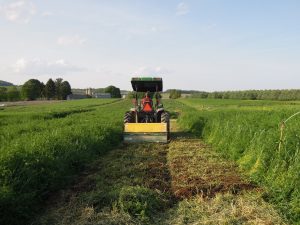
Seedling beds were prepared by tilling in cover crop mixture, disking, and shaping the beds for either bare ground or laying down black plastic. No spring tillage was required for the low- and high-input technologies. Cover crop mixtures were rolled-crimped with a 2-ft wide BCS crimper or a 10-ft wide roller-crimper, respectively.
The treatments at the partnering Quiet Creek farm:
- Grower's standard method – Bare ground treatment: includes tilled-in cover crops, transplanting with the water wheel transplanter, and seasonal mechanical cultivation;
- No-till, low-input technology- This treatment includes rolling cover crops into mulch using a 2-ft wide walk-behind BCS roller-crimper and transplanting by hand. The BCS is a two-wheeled small farm implement with a removable shaft to which any number of tools can be attached such as a 2-ft roller-crimper, mower or tiller;
- No-till, high-input technology - This treatment includes rolling cover crops into mulch using a 10-ft wide roller-crimper driven by a tractor and transplanting with a no-till transplanter.
At the Rodale Institute Research Farm, in a randomized complete block design with four replications, treatments 2 and 3, mentioned above, were compared to the black plastic treatment (which includes tilled in cover crop, black plastic, transplanting with a water wheel transplanter and seasonal mechanical cultivation). Winter squash was grown in 10 ft x 50 ft beds.
Cover crop planting:
At the Good Farm, a cover crop mixture of wheat, hairy vetch and crimson clover were established in September 2016, while at Rodale Institute Research Farm, a cover crop mixture of cereal rye and Austrian winter pea were established in mid-September 2016.
Cover crop and soil sampling and assessments:
Samples of cover crop biomass were collected from 0.5 m2 quadrats on May 16, 2017, and dried in the oven for dry weight and nutrient analyses. Similarly, soil samples were collected at 0-20 cm deep, dried and sieved for chemical analysis. However, for biological analysis, samples were taken from 3 inches deep, packed in an ice chest filled with ice and transported to Rodale Institute's Laboratory and stored frozen until analysis. Similarly, soil samples were taken at the end of the season before harvest to assess for physical, chemical and biological properties. Soil bulk density and soil compaction were assessed at the beginning and the end of the season. The depths at which soil penetrometer readings of 300 psi were recorded and the averages of three readings per treatment were used to determine the depths where root growth would be restricted.
The cover crop biomass in plots that were flagged for low- and high-input technologies was rolled and crimped twice, on May 24 and June 1, 2017 (Photos 2 and 3).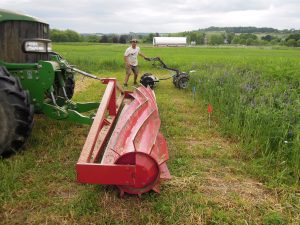
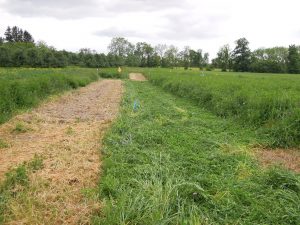
Soil health measurements were taken for physical, chemical and biological properties:
- At the partnering farmers' site: composite soil samples from 0-20 cm deep were collected three times during the growing season from each treatment from 3 replications, air-dried, sieved through 2-mm sieve and sent for chemical analysis (pH, macro and micro nutrients, organic matter, carbon and nitrogen) to the Agricultural Analytical Services Laboratory (AASL) at Penn State University. For biological analysis, moist soil cores collected from 0-8 cm deep were put on ice in an ice chest and shipped overnight to Ward Laboratory for biological assessment. Soil samples were collected at beginning of the season, mid-season (first signs of fruit formation) and before harvest. At the same time, physical properties such as bulk density and compaction were determined in-house. A penetrometer was used to measure sub-surface compaction by recording the soil depth at which root penetration was hindered (300 psi).
- At Rodale Institute Research Farm: Soil samples were assessed for chemical properties and biological properties at the above-mentioned laboratories.
Crop production and weed management:
- Seedlings of butternut squash ('Waltham') were transplanted into two rows per plot with 24 inch spacing between plants using the water wheel transplanter for the standard treatment (Photo 4)
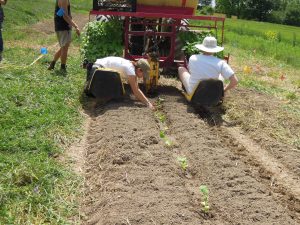 and no-till planter for the rolled-crimped plots (Photo 5).
and no-till planter for the rolled-crimped plots (Photo 5). 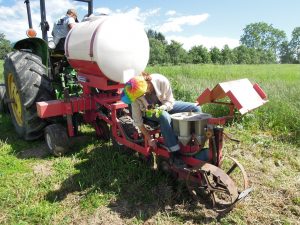 All seedlings received a fish emulsion solution at the date of planting. The Goods did not add any irrigation system to this study because they usually produce rain-fed winter squash.
All seedlings received a fish emulsion solution at the date of planting. The Goods did not add any irrigation system to this study because they usually produce rain-fed winter squash. - Weed species such as ragweed, foxtail, galinsoga, and pigweed compete with the young winter squash seedlings during the growing season. The standard practice of weeding for bare ground production is two to three mechanical cultivations before winter squash plant branching exceeds bed width. Additionally, in the black plastic treatment, 1-2 seasonal cultivations between rows is typical. Treatments with cover crop mulches require no cultivation.
- Hand-hoeing and in-season cultivation were accomplished in the standard treatment on June 22 and July 10, 2017, respectively. In the rolled-crimped treatments, weeds were only hand-weeded once.
- Weed density and biomass: Assessment of weed density (number per area) and biomass (weight per area) were conducted per treatment, replicated before transplanting, at mid-season and before harvest. Weeds in 5.4 ft2 (0.5 m2) quadrants were counted and cut, dried at 65 oC and weighed.
Leaf and fruit sampling:
Leaf tissue samples (17 per treatment) were collected and placed in paper bags, oven- dried for four days at 55 C then ground and analyzed for nutrients at Penn State University's Agricultural Analytical Services Laboratory.
Winter squash fruits were harvested in early September 2017,cured in the greenhouse, and weighed. Fruits subsamples were collected for nutrient quality determinations after being stored for 0, 30, and 60 days.
Crop yield:
At harvest, Dr. Zinati harvested and recorded the number and weight of marketable and unmarketable fruits per treatment per replication from 20-ft long rows.
Crop nutrient quality:
Winter squash fruits per treatment were harvested at maturity and stored for 0, 30, and 60 days in a cool and dark room. At the end of each storage date, fruits were processed by removing seeds and opposite longitudinal portions of the fruits were manually prepared by peeling the skin of fruits, dicing the fresh pulp into cubes, and placing in plastic bags at -20 C. Frozen samples then were freeze-dried, using the Labconco freeze-drier, ground, and stored immediately in dark amber jars, to protect the ground samples from degradation by UV light. Subsamples were sent to Dr. Reddivari's laboratory at Purdue University for quantification of carotenoids (Lutein and a- carotene) and total polyphenols. Results are expressed as mg equivalent per g of fruit dry weight. For Polyphenols, results are expressed as mg gallic acid equivalents (GAE) per g of fruit dry weight. For mineral nutrient analyses, fruit subsamples were sent to the PSU AASL.
Rodale Institute's site:
Measurements on soil compaction were taken on April 11, 2017, followed by weed measurements, cover crop (rye and Austrian pea mix) biomass sample collection, and soil sampling for physical and chemical analyses on May 11, 2017, following the same methods listed under the grower's treatment. The cover crop in the plasticulture treatment was mowed using a flail mower and the soil was moldboard-plowed on May 11, 2017, then disked twice on May 11 and 16, 2017. The plastic mulch was laid on May 24, 2017 (representing the standard treatment) with drip irrigation. Cover crop biomass was rolled-crimped using a walk-behind BCS (representing the low-input technology treatment) and a 10-ft roller crimper front-driven by a tractor (representing the high-input technology treatment) on May 24 and June 1, 2017 (Photo 6). 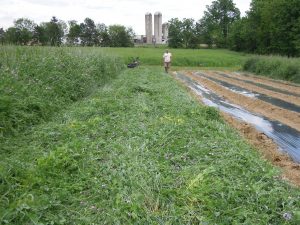 Seedlings of butternut squash 'Waltham' were transplanted into two rows per plot with 24 inch spacing between plants using the water wheel transplanter for the standard treatment (plastic mulch, Photo 7)
Seedlings of butternut squash 'Waltham' were transplanted into two rows per plot with 24 inch spacing between plants using the water wheel transplanter for the standard treatment (plastic mulch, Photo 7) 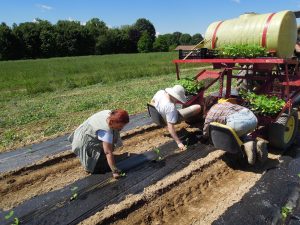 on June 1, 2017 and no-till planter for the rolled- crimped plots (Photo 8)
on June 1, 2017 and no-till planter for the rolled- crimped plots (Photo 8) 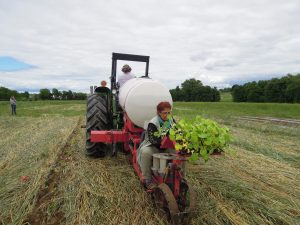 with drip irrigation on June 7, 2017. All seedlings received fish emulsion solution at planting.
with drip irrigation on June 7, 2017. All seedlings received fish emulsion solution at planting.
Weed-free areas were established on July 11, 2017 and weed counts were recorded in 0.5 m2 quadrats. Compaction measurements using a penetrometer were taken on August 15, 2017. Leaf tissue samples were taken on July 6, 2017. Winter squash fruits were harvested from weed-free areas on August 30, 2017. Fruits were cured in the greenhouse for two weeks and subsamples of marketable fruits per treatment were weighed and stored at 0, 30, and 60 days in a dark cool room. At the end of each storage period, fruits were cut open and sections from the edible portion were stored at -20 °C. Frozen samples were freeze dried and will be sent to Dr. Lavanya Reddivari's Laboratory at Purdue University for carotenoid analyses and to the PSU AASL for nutrient analysis.
Statistics and data presentation:
Weed biomass and density, crop yield and quality, and soil health per site were assessed. Collected data on weed, yield, crop nutrient content, soil quality indicators, and profitability were e compiled, and analyzed by standard ANOVA using the generalized linear model (GLM) of SAS® 9.3. Estimated economic benefits of each system were prepared based on inputs such as hours and cost of weeding, cultivation, farmer return, profit and benefits gained for soil health. Analyzed data were presented in tables and written in technical and scientific formats (see outreach section).
Expectation of proposed method:
We expected to demonstrate the pros and cons of the reduced-tillage proposed method in comparison to the standard cultivation method and provide the partner growers and vegetable growers with results that allow them make informative decisions to conserve soil health and produce crops with high nutrient value.
Results
Grower's site
Cover crop biomass and plant height: The average height for the cover crop mix of hairy vetch, crimson clover and wheat was 92.08 cm (36.25 in), 32.67 cm (12.86 in), and
57.10 cm (22.48 in), respectively. The mean cover crop mix biomass was 4,111 kg/ha (3,670 lb/acre). While this value may be satisfactory for the standard grower's treatment (cultivation), it was well below the threshold value (greater than 8,000 kg/ha) identified for consistent suppression for annual weeds under rolled-crimped management systems.
Weed species and biomass: Weed species were identified and were dominated by chickweed, henbit, aster, pennycress, and wild mustard. The mean weed biomass at the beginning of the season was 479 kg/ha (427 lb/acre). However, weeding was necessary in all treatments during the growing season. The low biomass of rolled-crimped cover crop did not provide season-long weed control as was expected.
Soil physical properties: Bulk density at the beginning of the season was 0.68 g/cm3 in the standard treatment and 0.88 g/cm3 in rolled-crimped treatments. However, at the end of the season, soil bulk density values increased to 1.00 g/cm3 in all treatments. Soil compaction values read by a penetrometer were not significantly different between treatments at the beginning (27.5, 23.63, and 20.40 cm, Standard, BCS, and RC, respectively) and at the end of the season (37.50, 35.00, and 35.00, Standard, BCS, and RC, respectively). However, results showed that the soil was less compacted (greater readings) at the end of the season under any management system.
Fruit phytochemical and mineral nutrients concentrations: Mean concentrations of polyphenols in winter squash, expressed as mg gallic acid equivalents (GAE) per g dry weight, did not vary significantly among treatments at 0-day storage (Table 1. Total phenolic compounds (GAE), Lutein and a- carotenoid in butternut winter squash under storage periods and management practices, Kutztown, Pennsylvania.).ONE17-308_Table-1 However, total polyphenol concentrations increased by 1.75 times, 2 times, and 1.5 times in BCS, RC, and grower's standard treatments, respectively, as storage periods increased from 0 days to 30 and 60 days. Mean concentrations of lutein and a-carotene in winter squash increased significantly in the RC treatment as storage periods increased from 0 days to 60 days (Table 1).ONE17-308_Table-1 However, in the standard treatment, the mean concentrations of lutein and a-carotene declined significantly in winter squash by 30 days (lutein) and 60-days (a-carotene).
There was no significant difference in mean N (not presented in the Table 2) and Mg concentrations in winter squash fruit tissue between treatments and as storage periods increased (Table 2. Mean nutrient mineral concentrations in butternut winter squash in the pulp of fruits of butternut winter squash, Kutztown, Pennsylvania.).ONE17-308_Table-2 Nitrogen concentration ranged between 1.02 percent and 1.16 percent, whereas Mg concentrations ranged between 0.11 and 0.13 percent. Mean P concentration in winter squash increased significantly as the storage period increased from 0 to 30 and 60 days in the BCS and RC treatments when compared to the standard treatment (Table 2). The increase in K concentrations in winter squash was more pronounced in the BCS and RC treatments as storage periods increased when compared to the standard treatment (Table 2).ONE17-308_Table-2 Calcium concentrations in winter squash increased significantly and almost doubled in the BCS treatment as the storage period increased to 60 days when compared to those in freshly-harvested fruits (Table 2). ONE17-308_Table-2Similarly, Ca concentrations in winter squash in the RC treatment increased but not significantly as the storage period increased, ranging between 0.13 and 0.17 percent. In comparison, Ca concentrations in winter squash under the standard treatment did not vary significantly as the storage period increased, averaging 0.13 percent. Despite the decline in Mn concentrations in winter squash from 3.90 ppm at 0 days storage to 2.90 ppm at 60 days storage in the BCS and RC treatments, Mn concentration was greater in these treatments when compared to those in the standard treatment (Table 2). The differences in the latter were negligible after 30 days of storage. The mean Fe concentrations in winter squash did not vary significantly in the BCS and RC treatments as the storage period increased, ranging between 16 ppm and 22.5 ppm (Table 2). ONE17-308_Table-2 However, Fe concentrations fluctuated in the standard treatment but were similar to that of the RC at 60-day storage, averaging 21ppm.
Rodale Institute's site
Cover crop biomass: The rye/Austrian pea biomass was low, ranging from 2,987 kg/ha to 4,440 kg/ha total dry weight, which is below the minimum target of 8,000 kg/ha for good weed control in rolled-down cover crop systems. The low biomass of the cover crop is attributed to the cool and wet spring season in 2017.
Weeds species and biomass: The field site was heavily infested with weeds. Chickweed, dandelion, and mustard were the dominant weed species in all treatments. The high weed biomass in the BCS and RC treatments (2,662 kg/ha) resulted in significantly lower crop yields than in plasticulture treatment (305 kg/ha).
Crop yield: The plasticulture treatment yielded 12,347 kg/ha (11,016 lb/acre) whereas the BCS and the RC treatments yielded 3,658 kg/ha (3,264 lb/acre). The plasticulture treatment out-yielded the BCS and RC treatments which may be attributed to lower weed pressures and warmer conditions under plastic compared to rolled-crimped mulch, and more nitrogen availability to plants.
Soil physical properties: Average soil bulk density was similar between treatments ranging from 1.00 to 1.14 g/cm3. Soil compaction measurements at the beginning and end of the season in the BCS and RC treatments were 33.83 cm and 32.50 cm, respectively, and they were not significantly different from those in plasticulture treatment (33.78 cm and 30.65 cm, respectively).
Preliminary results showed that the biomass of the cover crop mix was below the threshold level needed for consistent suppression of spring and summer annual weeds in rolled-crimped treatments. The partnering growers realized the importance of choosing the cover crop mix and its role in providing a high biomass of rolled-crimped mulch to suppress weeds and reduce weeding activities once they transition to using the proposed technologies. Initially, we recommend that for successful production of winter squash in no-till low- or high-input technology management systems, the growers should select a field site that is not heavily infested by weeds. Soil compaction in the proposed technologies (low-input and high-input) was similar to that in the standard treatment (cultivation).
After one growing season, the soil compaction was reduced in all treatments. However, soil bulk density slightly increased at the end of the season compared to the beginning of the season. Statistical analyses of crop yields, weed diversity, and soil chemical and biological properties are currently underway. Videos on using the roller-crimper with the BCS and 10-ft roller crimper will be prepared. Results from this project were shared with growers at the Mid-Atlantic Fruit and Vegetable Convention in Hershey, PA in January 2018 and project results were posted in a web article on Rodale Institute's web site.
Research conclusions:
Our results showed that crop yield was lower in reduced-tillage management systems due to low cover crop biomass [4,111 kg/ha (3,670 lb/acre)], well below the optimal threshold biomass of 8,000 kg/ha (7,000 lb/acre) when compared to the grower's standard system. However, using reduced-tillage management systems enhanced nutrient concentration of a-carotene, lutein, calcium, and phosphorus in winter squash when stored for 60 days. Total polyphenol concentrations increased by 1.75, 2, and 1.5 times in the BCS, RC, and grower's standard treatments, respectively, as storage periods increased from 0 to 30 and 60 days. Vegetable growers who have limited resources and capital may start by using the BCS system, an affordable low-input management technology, to roll-crimp the cover crops while producing high quality winter squash. In addition to enhanced nutrient levels of winter squash when using the high-input technology method, growers will observe reductions of 1/5 the time required to roll-crimp the cover crop and 1/6 the time required to transplant seedlings as compared to those of the low-input technology system.
Education & Outreach Activities and Participation Summary
Participation Summary:
Outreach and Education:
- John Good, our partnering grower was trained, interviewed, and videoed on the use of the 10-ft roller-crimper on June 16, 2017 (Photo 9)
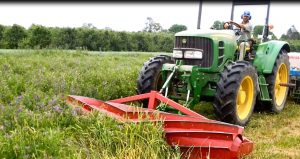 . Two other growers (one of whom is a new grower) were trained on using the BCS on June 1 and June 5, 2017 (Photos 10 and 11).
. Two other growers (one of whom is a new grower) were trained on using the BCS on June 1 and June 5, 2017 (Photos 10 and 11).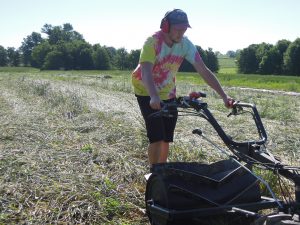
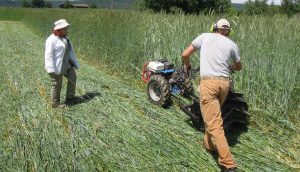
- The site was visited by researchers from Iowa State University on May 24, 2017, and by 21 farmers from Norway on June 13, 2017 (Photo 12)
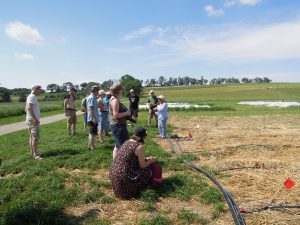 and 13 Argentinian delegates on June 7, 2017.
and 13 Argentinian delegates on June 7, 2017. - Twenty six farmer apprentices of the northeast region registered under the CRAFT (Collaborative Regional Alliance for Farmer Training) program and 12 interns were engaged in and demonstration and hands-on experience on measurements of soil compaction (Photos 13-16)
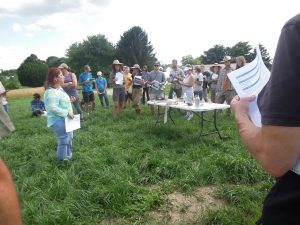
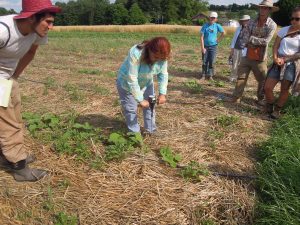
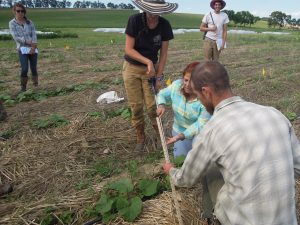
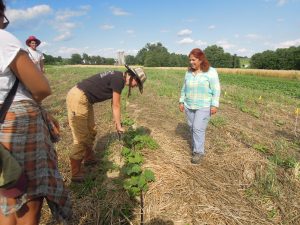 and soil sampling (Photo 17)
and soil sampling (Photo 17)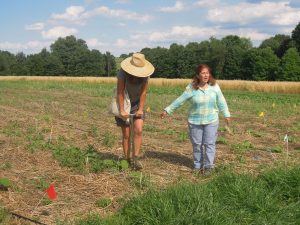 on June 28, 2017.
on June 28, 2017. - Dr. Zinati showcased the project to the over 200 attendees of the Rodale Institute’s Annual Field Day and discussed the objectives and the equipment being used for rolling and crimping of cover crop on July 21, 2017 (Photo 18)
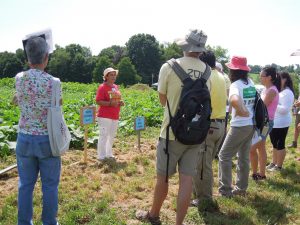 .
. - An article entitled "Squash Systems Comparison" was published in NEW FARM in the Fall 2017 and was emailed to 10,000 readers on September 9, 2017 (Article 3).Article-3-New-Farm-Fall-2017-Article_Squash-Systems-Comparison
- A web article entitled "Reduced-Tillage Increases Nutrient Concentrations in Stored Winter Squash: Alpha-Carotene, Lutein, Phosphorus and Calcium" was published on Rodale Institute's website(www.rodaleinstitute.org) in February 2019 (Article 2).Article-2-Reduced-tillage-Nutrient-Winter-Squash1
- An article entitled "No-Till and Cover Cropping for Vegetables" was published in the Country Folks E-Newsletter in February 2019 (Article 1).Article-1-No-Till-and-Cover-Cropping-for-Vegetables1 Country Folks is a weekly publication serving the Northeast and Mid-Atlantic agriculture industries. The February e-newsletter has a readership of about 12,000.Article-1-No-Till-and-Cover-Cropping-for-Vegetables21
-
Dr. Zinati made an oral presentation titled “Impact of Management Practices on Yield, Soil Properties, and Plant Phytochemicals Content in Organic Winter Squash” at the 2018 ASHS Conference in Washington, D.C., August 1, 2018.
-
Dr. Zinati made an invited oral presentation titled “Cover Crops and No-Till in Organic Vegetable and Field Production Systems” at the 2018 Cover Crop and No-Till Conference at the Hawke Pointe Golf Course, Washington, NJ on December 13, 2018.
Learning Outcomes
Farmers reported changes in knowledge about cost-effectiveness in using low-input technology and high-input technology. Five growers received training on using the BSC roller-crimper to roll small plots and the 10-ft. roller crimper and transplanter on large plots. Our grower partner appreciated the training and gaining knowledge on improving nutrient quality when using reduced tillage methods.
Project Outcomes
Based on the results, John and Aimee Good are now considering using reduced tillage management, low-input technology, in their vegetable production system. They found that the low-input technology is cost effective for their land size while at the same time producing healthy, more nutrient rich fruits. Upon training, John Good on using high-input technologies such as 10-ft wide roller crimper and no-till transplanter, he became more convinced that using this technology saves him time and reduce costs of production in the future, as he expands his production land.
AREAS FOR FURTHER STUDY
In addition to analyses proposed in this project, we would like to also assess the impact of reduced tillage and fertilizer management systems over an extended period storage on fruit quality; specifically minerals, sugars and phytochemicals in the winter squash. These analyses will benefit the project by providing additional data on nutrient density in winter squash fruits under different management systems. The data will address the grower’s interest in selecting management systems that improve soil and plant health and provide healthier, nutrient rich fruits for the consumer, while at the same time improving farm income.